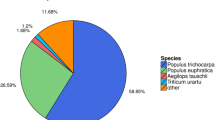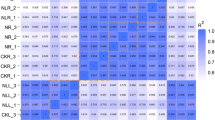Abstract
Populus spp., had the characteristics of rapid growth and high biological yield, is one of the major tree species in the world’s afforestation and shelterbelt. But the growing soil salinization has become an important limited factor in the application of poplar planting. High-throughput sequencing technology was used to analyze the transcriptome of Populus × euramericana cv. ‘74/76’ under treatments with different NaCl concentrations to determine the formation pathway of the poplar response to salt stress and further reveal the mechanism of resistance to salt stress, so providing theoretical guidance for the salt tolerant breeding of poplar. Sequencing obtained 31.5G sequencing data and generated a total of 263 million reads, which were mapped to 32,840 non-repeatable genes with a sequencing quality value of Q30 > 96.70%. After filtering, 292 and 3284 differentially expressed genes (DEGs) were obtained from 3 and 6‰ NaCl treatments, respectively. There were a large number of stress-induced genes differentially expressed under the 6‰ NaCl treatment. Gene ontology (GO) and Kyoto Encyclopedia of Genes and Genomes (KEGG) enrichment analysis results showed that the salt resistance mechanism of poplar 107 was different under different NaCl treatments. Poplar 107, under a high NaCl concentration treatment had a more salt resistant metabolic pathway, which included the citric acid cycle [tricarboxylic acid (TCA) cycle], terpenoid backbone biosynthesis, flavone and flavonol biosynthesis, carotenoid biosynthesis, zeatin biosynthesis, calcium signaling pathway, and other important salt-related pathways. We excavated the genes that affected the electron transport involved in the process of photosynthesis under salt stress and the key enzyme genes in response to salt stress involved in glutathione and terpenoid backbone metabolism. A total of 52 transcription factors (TFs), including 24 new TFs closely related to the salt stress response mechanism, were identified in the co-expression genes. This result provided important theoretical guidance for the establishment of the poplar salt resistance database, excavation of salt tolerant genes, and breeding of new species of poplar by means of molecular biology.






Similar content being viewed by others
References
Allahverdiyeva Y, Suorsa M, Rossi F, Pavesi A, Kater M, Antonacci A, Tadini L, Pribil M, Schneider A, Wanner G, Leister D, Aro E-M, Barbato R, Pesaresi P (2013) Arabidopsis plants lacking PsbQ and PsbR subunits of the oxygen-evolving complex show altered PSII super-complex organization and short-term adaptive mechanisms. Plant J 75(4):671–684
Barber J, Rivas JDL (1993) A functional model for the role of cytochrome b559 in the protection against donor and acceptor side photoinhibition. Proc Natl Acad Sci 90(23):10942–10946
Ding QM, Hou PH, Shen X, Wang MJ, Deng SR, Sun J, Xiao F, Wang RG, Zhou XY, Lu CF, Zhang DQ, Zheng XJ, Hu ZM, Chen SL (2010) Salt-induced expression of genes related to Na+/K+ and ROS homeostasis in leaves of salt-resistant and salt-sensitive poplar species. Plant Mol Biol 73(3):251–269
Fan XD, Wang JQ, Yang N, Dong YY, Liu L, Wang FW, Wang N, Chen H, Liu WC, Sun YP, Wu JY, Li HY (2012) Gene expression profiling of soybean leaves and roots under salt, saline-alkali and drought stress by high-throughput Illumina sequencing. Gene 512(2):392
He QJ, Li N, Zhou WW, Wang B (2014) The response of chlorophyll content of phyllostachys violascens to nacl stress. J Bamboo Res 33(2):58–62
Hiz MC, Canher B, Niron H, Turet M (2014) Transcriptome analysis of salt tolerant common bean (Phaseolus vulgaris L.) under saline conditions. PLoS One 9(3):e92598
Hong B, Ma C, Yang Y, Wang T, Yamaguchi-Shinozaki K, Gao J (2009) Over-expression of AtDREB1A in chrysanthemum enhances tolerance to heat stress. Plant Mol Biol 70(3):231–240
Huang J, Duan XW, Zhang WN, Meng D, Chao MA, Hao L, Li TZ (2015) Clone of pear HMGRgene and salt-tolerance analysis of its transgenic tobacco seed. J China Agric Univ 20(1):60–67
Jansson S, Douglas CJ (2007) Populus: a model system for plant biology. Annu Rev Plant Biol 58(1):435–458
Janz D, Behnke K, Schnitzler JP, Kanawati B, Schmittkopplin P, Polle A (2010) Pathway analysis of the transcriptome and metabolome of salt sensitive and tolerant poplar species reveals evolutionary adaption of stress tolerance mechanisms. BMC Plant Biol 10(1):150
Ji W, Zhu Y, Li Y, Yang L, Zhao X, Cai H, Bai X (2010) Over-expression of a glutathione s-transferase gene, gsgst, from wild soybean (glycine soja) enhances drought and salt tolerance in transgenic tobacco. Biotech Lett 32(8):1173–1179
Liao Y, Peng YG, Chen GZ (2007) Research advances in plant salt-tolerance mechanism. Acta Ecol Sin 27(5):2077–2089
Lichtenthaler HK (1987) Chlorophylls and carotenoids: pigments of photosynthetic biomembranes. Methods Enzymol 148(1):350–382
Ma XY, Deng L, Li JK, Zhou XY, Li NY, Zhang D, Lu YJ, Wang RG, Sun J, Lu CF, Zheng XJ, Fritz E, Hüttermann A, Chen SL (2010) Effect of NaCl on leaf H+-ATPase and the relevance to salt tolerance in two contrasting poplar species. Trees 24(4):597–607
Pang T, Ye CY, Xia XL, Yin WL (2013) De novosequencing and transcriptome analysis of the desert shrub, Ammopiptanthus mongolicus, during cold acclimation using Illumina/Solexa. BMC Genom 14(1):488
Peng X, Ma X, Fan W, Su M, Cheng L, Iftekhar A, Lee B, Qi D, Shen S, Liu GS (2011) Improved drought and salt tolerance of Arabidopsis thaliana by transgenic expression of a novel DREB gene from Leymus chinensis. Plant Cell Rep 30(8):1493–1502
Plöchinger M, Schwenkert S, Sydow LV, Schröder WP, Meurer J (2016) Functional update of the auxiliary proteins psbw, psby, hcf136, psbn, terc and alb3 in maintenance and assembly of PSII. Front Plant Sci 7:423
Postnikova OA, Shao J, Nemchinov LG (2013) Analysis of the alfalfa root transcriptome in response to salinity stress. Plant Cell Physiol 54(7):1041
Sappl PG, Carroll AJ, Clifton R, Lister R, Whelan J, Harvey Millar A, Singh KB. (2009) The Arabidopsis glutathione transferase gene family displays complex stress regulation and co-silencing multiple genes results in altered metabolic sensitivity to oxidative stress. Plant J 58(1):53–68
Seki M, Umezawa T, Urano K, Shinozaki K (2007) Regulatory metabolic networks in drought stress responses. Curr Opin Plant Biol 10(3):296–302
Sheehan D, Meade G, Foley VM, Dowd CA (2001) Structure, function and evolution of glutathione transferases: implications for classification of non-mammalian members of an ancient enzyme superfamily. Biochem J 360(Pt 1):1–16
Strogonov BP (1973) Structure and function of plant cells in saline habitats. J Wiley 2(4):213–215
Suorsa M, Sirpio S, Allahverdiyeva Y, Paakkarinen V, Mamedov F, Styring S, Aro EM (2006) PsbR, a missing link in the assembly of the oxygen-evolving complex of plant Photosystem II. J Biol Chem 281(1):145–150
Szkopińska A, Płochocka D (2005) Farnesyl diphosphate synthase; regulation of product specificity. Acta Biochim Pol 52(1):45–55
Tholl D (2015) Biosynthesis and biological functions of terpenoids in plants. Adv Biochem Eng 148:63–106
Toshikazu T, Minako I, Hiroyuki K, Nanako K, Ikuo N (2002) Over-expression of zete glutathione S-transferase in transgenic rice enhances germination and growth at low temperature. Mol Breed 9(2):93–101
Umena Y, Kawakami K, Shen JR, Kamiya N (2011) Crystal structure of oxygen-evolving photosystem II at a resolution of 1.9 Å. Nature 473(7345):55–60
Von SL, Schwenkert S, Meurer J, Funk C, Mamedov F, Schröder WP (2016) The psby protein of arabidopsis photosystem II is important for the redox control of cytochrome b559. Biochim Biophys Acta 1857(9):1524–1533
Wang XZ, Han WH, Yu GJ (2004) Effects of salt stress on physiological-biochemistry index of different tomato seedling. North Horticul 3:48–49
Wang Y, Zheng Z, Yang M, Li ZL, Liang HY, Yan HX (2007) Expression of exogenous gene and correlation analysis of characters of transgenic triploid of Chinese white poplar carrying two insect resistance genes. Acta Entomol Sin 50:907–913
Wang FF, Ding MQ, Deng SR, Wang MJ, Sun J, Hou PC, Ma XJ, Zhang YH, Zhao N, Shen X, Chen SL (2012) Cloning of glutathione peroxidase gene PeGPX from Populus euphratica and the salt tolerance of the transformed plants. Genom Appl Biol 31(3):231–239
Xu Q, Bricker TM (1992) Structural organization of the proteins on the oxidizing-side of photosystem II: two molecules of the 33 kDa manganese-stabilizing protein per reaction center. J Biol Chem 267(36):25816–25821
Yang Z, Park H, Lacy GH, Cramer CL (1991) Differential activation of potato 3-hydroxy-3-methylglutaryl coenzyme A reductase genes by wounding and pathogen challenge. Plant Cell 3(4):397–405
Yu T, Chen XF, Hu J, Chang X, Zhu YG (2003) Transgenic tobacco plants overexpressing cotton glutathione S-transferase (GST) show enhanced resistance to methyl viologen. J Plant Physiol 160(11):1305–1311
Zhang QW (1999) A new poplar variety for pulpwood and ecological protection forest, Populus × euramericana cv.’74/76′. For Res 12(3):332
Zhou QY, Tian AG, Zou HF, Xie ZM, Lei G, Huang J, Wang CM, Wang HW, Zhang JS, Chen SY (2008) Soybean WRKY-type transcription factor genes. GmWRKY13, GmWRKY21, and GmWRKY54, confer differential tolerance to abiotic stresses in transgenic Arabidopsis plants. Plant Biotechnol J 6(5):486–503
Zouni A, Witt HT, Kern J, Fromme P, Krauss N, Saenger W, Orth P (2001) Crystal structure of photosystem II from Synechococcus elongatus at 3.8 Å resolution. Nature 409(6821):739–743
Acknowledgements
This study was supported by the National Key Program on Transgenic Research of China (2018ZX08021001) and the Basic Research Plan Project of Hebei Province (18966801D).
Author information
Authors and Affiliations
Corresponding author
Ethics declarations
Conflict of interest
Then authors declare that they have no conflict of interest.
Additional information
Communicated by L. Bavaresco.
Electronic supplementary material
Below is the link to the electronic supplementary material.
Rights and permissions
About this article
Cite this article
Chen, P., Zuo, L., Yu, X. et al. Response mechanism in Populus × euramericana cv. ‘74/76’ revealed by RNA-seq under salt stress. Acta Physiol Plant 40, 96 (2018). https://doi.org/10.1007/s11738-018-2676-x
Received:
Revised:
Accepted:
Published:
DOI: https://doi.org/10.1007/s11738-018-2676-x




